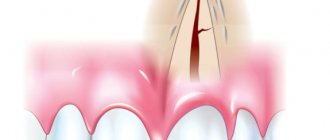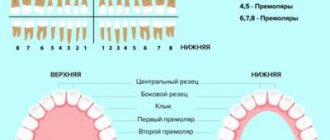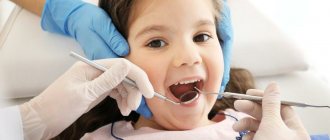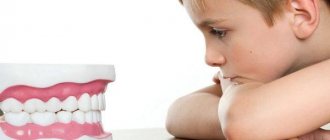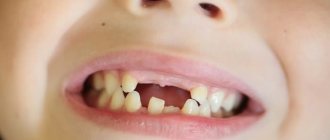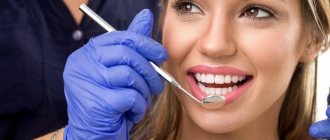Content:
- A competent approach to the problem
- If the very first teeth are crooked
- Causes of crooked teeth
- What to do if a tooth grows crookedly
- Do I need to straighten crooked teeth?
Seeing that a canine or incisor is “looking in the wrong direction,” parents immediately ask the question whether baby teeth can grow crooked. Knowing the correct answer to this is very important, because failure to take therapeutic measures in a timely manner can result in an unaesthetic smile in adulthood.
A competent approach to the problem
Dentists recommend bringing children for routine examinations to the dental clinic starting from the age of two. Already at this age, the doctor can discern the features of the developing bite and tell whether additional corrective measures will be required. If some teeth erupt very crookedly, he will tell you how they can be straightened so that in the future they will stand correctly.
Some mothers and fathers consider such careful attention to a child’s crooked baby teeth to be unnecessary. They explain their position by the fact that temporary teeth will soon fall out, and it is possible that they will be replaced by straight permanent ones.
Of course, you can hope for chance. As practice shows, a crooked baby tooth is often replaced by an equally permanent one. The doctor will conduct a diagnosis and determine whether the growth of the unit needs to be adjusted. Parents can rest assured that modern methods of preventing serious orthodontic problems do not cause pain or discomfort. Therefore, they can be safely used even when working with three-year-old children.
How to grow straight teeth in a child
Beautiful, straight teeth are a source of pride, one of the components of a charming appearance.
Anything that prevents teeth from growing straight is much easier to correct in childhood. How? Andrey Chubenko, an orthodontist at the Smile dental clinic, told us about this. How straight your teeth will grow depends on your bite. There are also pathologies of detached teeth, in which some teeth grow crookedly. It is possible to predict what the bite will be and what the teeth will be like even in infants, even with toothless jaws.
Normally, the upper jaw should overlap the lower jaw. However, all children are born with so-called newborn prognathia, when the lower jaw protrudes forward. This is directly related to sucking. Over time, the lower jaw moves back and becomes behind the front. When teething begins, the height of the bite is established and the jaws return to their height. First, a replaceable bite is formed (on baby teeth), and then a permanent one. Essentially, they are no different from each other. In addition to the fact that in late occlusion, before the change, normally the front milk teeth should diverge, and gaps should form between them. If for some reason gaps do not form, this means that there will be little space for permanent teeth.
What does the bite depend on:
- hereditary factor. There are congenital malocclusion pathologies that are inherited;
- type of feeding: breast or artificial. If the child has been breastfed for a long time, then the chances of good teeth will be higher;
- nature of nutrition. If a child does not like to eat hard foods, then there is no natural stress on baby teeth;
- presence of bad habits: biting nails, pens and other objects. The bones of young children are still soft and pliable, and the habit of gnawing on various objects can lead to malocclusion;
- adenoids. Lack of normal nasal breathing leads to the development of pathological bites;
- speech therapy pathologies. For example, an anatomically large tongue.
Individual dental pathologies may also occur. These are the cases when the orthodontist says that the bite is normal, but some teeth are uneven. Most of the teeth, especially the front ones, erupt unevenly. This is normal because the jaws are in a perpendicular position. As the teeth erupt, they unfold; as the jaws grow, more space for the teeth increases, and they straighten out. But it happens that the baby tooth has not yet fallen out, while the permanent one has already begun to erupt, it does not allow the permanent one to grow in the correct position. This problem can be avoided if the baby tooth is removed in a timely manner. Over time, under the influence of the lips, tongue, and hard food, all the teeth fall into place. If this does not happen, then the teeth can be corrected with the help of an orthodontist.
When to see the orthodontist?
At 2-3 years old, when baby teeth have already erupted and the child has become relatively interactive, he can already be brought to an initial consultation so that the doctor (dentist and orthodontist) can see how his teeth are developing. At this age, bite pathologies already occur. For example, when the lower jaw comes forward and does not allow the upper jaw to form normally. Such children can be treated with orthodontic appliances. Most often this is removable equipment - records. Whether the child will wear this plate depends on the child himself and the persistence of the parents. It is also advisable to periodically monitor how teeth are cutting through.
If there is a need to monitor the development of the situation, then the orthodontist will recommend how often to visit him. As a rule, patients come for dispensary treatment every six months. In certain situations, more frequent consultations are necessary.
If the doctor does not find any pathologies, in any case you should visit the dentist once every 3 months. An experienced dentist will always notice the problem and recommend an orthodontic consultation. Pathology can occur at any age until the development of the dental system ends with the eruption of wisdom teeth. When wisdom teeth erupt, pathology may begin to develop. Teeth may become crooked, especially in the front area. In some cases, the doctor may recommend removing wisdom teeth before they emerge.
How to fight for straight teeth?
The orthodontist makes recommendations depending on whether there is obvious pathology or only prerequisites for its occurrence.
Assumptions should be dealt with depending on what they are related to. If you have difficulty breathing through your nose, the doctor will recommend solving the problem of the adenoids, including surgical intervention. If a child has bad habits, then you need to fight them hard, using parental tricks, as well as the help of a neurologist or psychologist. Regular speech therapy or orthodontic exercises help to cope with individual teeth that are crooked.
It is better to deal with malocclusion at the earliest possible age. The sooner you start correcting your bite, the easier it will be to correct it. As early as 3 years old, if the doctor has recommended treatment, parents should be persistent in following the orthodontist’s recommendations. For bite pathologies, removable orthodontic equipment (various plates) and non-removable braces are used. Different pathologies require different periods and modes of wearing orthodontic equipment.
Records. Typically used for young children.
Pros. They are easy to take off and put on. The plates are absolutely painless.
Minuses. The baby may take off the plate and forget to put it on, while wearing the plate for less than 12 hours is ineffective.
Braces. They are used in adolescence, when the teeth have already completely changed. Now this is the age of 12-14 years.
Pros. Regardless of the child’s wishes, braces are worn around the clock. Braces come in different types: both metal and completely transparent. There are braces that are glued to the inner surface of the teeth. This way, the child can choose the braces he agrees to wear.
Minuses. Fixed treatment is more expensive. There are early methods of installing braces, from 6-7 years. In this case, the child will be in braces until all teeth erupt, which is 5-7 years. Considering that not every child knows how to brush their teeth efficiently, one can imagine what can happen to tooth enamel in such a period.
Prevention of straight teeth:
- Long-term breastfeeding;
- Eating hard foods that stimulate normal jaw development: carrots, crackers, apples. Chewing gums do not belong to such food!
- Timely consultation with an ENT doctor, and, if necessary, sanitation of the adenoids;
- Solving speech therapy problems, if any;
- No bad habits.
While the jaws are growing, they can be influenced to one degree or another. When the jaws stop growing, pathologies can only be corrected to the extent that the size of the jaws allows.
If the very first teeth are crooked
The first lower incisors erupt between the ages of six months and one year. They often grow in an "L" shape. This is the norm. This situation definitely does not require any treatment. By the time of complete eruption, the units are aligned and become correct.
If parents are very worried, they can speed up the process of stabilizing the position of the incisors. To do this, the baby should be given to drink from a bottle with a special tight nipple with a small hole. When using it, the baby will make more effort when sucking.
Another situation that should not worry is the even spacing between the first teeth. They disappear when the chewing units erupt. Dentists recommend paying attention only to uneven and too wide diastemas. They most often have to be closed with plates and braces.
Measures to help prevent the development of pathology
By understanding why a child’s baby and molar teeth are coming in crookedly, you can prevent the problem from occurring at the earliest stages. To do this, you must adhere to the following preventive measures:
- establishing breastfeeding;
- following the bottle feeding technique if the baby is fed formula;
- excluding pacifiers for children over one year old;
- getting rid of bad habits;
- introducing solid foods into the diet immediately after the appearance of the first teeth;
- daily high-quality oral hygiene;
- maintaining the balance of vitamins and minerals in the child’s body;
- Regular visits to the dentist (at least once every six months) for timely detection of orthodontic problems and prescribing effective treatment.
Causes of crooked teeth
There are quite a few factors that determine the curvature of milk units. Sometimes parents are to blame for the violation, because they do not allow their grown-up child to chew solid food on their own for too long or ignore the symptoms of calcium deficiency. It also happens that the curvature is caused by the individual characteristics of the baby’s body. This is what the most common causes of curvature look like:
- hereditary predisposition;
- chronic pathologies of the nasopharynx, forcing the baby to constantly breathe through the mouth;
- speech therapy disorders not corrected in a timely manner;
- too short frenulum, anatomically large tongue;
- bad habit of sucking fingers, gnawing foreign objects;
- Bottle feeding your baby once he or she reaches one year of age.
All these are factors that contribute to the curvature of baby teeth. If the violation is obvious, there is no need to panic. The doctor will select a method that will quickly straighten the teeth. Moreover, the sooner treatment is started, the better. Therefore, there is no need to delay seeking dental care.
Teeth changing mechanism
A child’s nature dictates a sequence of teething. They appear one after another in exact sequence. The central incisors are shown first, and then the lateral incisors, etc. They also fall out at a certain time. The replacement of baby teeth occurs at the age of 6 - 7 years, but there are also deviations. Undesirable factors can interfere with teething. It also happens that all deadlines are violated, in this case it is advisable to go to the dentist. If teething starts too early or late, then there is nothing wrong with it, don’t worry - it won’t affect the baby’s health.
What to do if a tooth grows crookedly
If parents see that a tooth is very crooked, there are uneven gaps between the units, they need to take the child to an appointment at the dental clinic. It is possible that their experiences are far-fetched. Then the doctor will calm you down and tell you how to properly care for your teeth so that the imaginary problem does not become a reality.
If there really is a curvature, removable orthodontic trainers will help remove it at the age of under seven years. They are a flexible silicone mouthguard. It forces the units to take the correct position. Most often it is enough to wear it only at night. But sometimes short wearing during the day is required.
Between the ages of seven and twelve years, the bite is corrected using removable plastic plates. They are made from individual casts. You can remove the mouthguard only when brushing your teeth and eating. The period of getting used to it takes from one to two weeks.
Braces are recommended for patients over 12 years of age. They are used for crooked permanent teeth. Breast units are never leveled using braces.
Do I need to straighten crooked teeth?
It is wrong to treat dental curvatures only from the standpoint of a violation of aesthetics. There is no need to think that the existing defect spoils the smile slightly, and therefore it is not necessary to correct it.
Incorrectly positioned teeth can also lead to more serious problems, such as poor hygiene. Then plaque will constantly accumulate in the interdental spaces. Pathogenic microorganisms will begin to actively multiply in it, which means caries will not be long in coming. If treatment is not carried out at this stage, the destructive process will spread to the deep tissues of the tooth and bone. Then removal will be required. If the milk unit is pulled out much earlier than the time when it should have fallen out on its own, its neighbors will take its place. And this is a serious malocclusion.
Another complication that crooked baby teeth lead to is uneven load on the jaw. It is fraught with abrasion of healthy teeth and disturbances in the functioning of the temporomandibular apparatus. It also negatively affects the functioning of the digestive and respiratory systems.
This is how many problems can arise due to a simple reluctance to straighten a crooked tooth. Therefore, do not delay your visit to the doctor. Take care of the health of your child's smile from early childhood.

